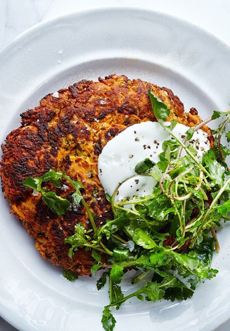
[1] Bacon and corn griddle cakes. Here’s the recipe from Recipe Girl (photo © Recipe Girl).

[2] These carrot pancakes, with salted yogurt, are gluten free. Here’s therecipe from Jessica Koslow at Bon Appetit (photo © Bon Appetit | Michael Graydon + Nikole Herriott).

[3] You don’t need to use wheat. Check out these flours (photo courtesy ).
|
|
September 26th is National Pancake Day. Normally, we’d make our favorite: buttermilk pancakes topped with smoked salmon, crème fraîche and chopped dill.
We’d love them with a topping caviar: We’ll have that daily when our ship comes in.
But until then, we’re not highbrow: Another favorite is chocolate pancakes with chocolate chips, topped with bananas and sour cream.)
Today’s tip is: Take a fresh look at pancakes.
Cultures around the world eat pancakes, both sweet and savory. Some have them as a main dish, some enjoy them as street food.
There are so many choices from East to West:
From Danish aebleskiver to Russian blini and latkes in Europe…
To Chinese scallion pancakes and Japanese okonomiya, filled with shredded cabbage and other choices from shrimp to vegetables.
In Malaysia, apam balik—folded pancakes—are made with rice flour and stuffed with a sweet peanut filling.
In Vietnam, different varieties include this “surf and turf” option with shrimp and pork (check out the recipe).
In Somalia, anjero is a fermented, crepe-like pan bread made from sorghum and corn flowers. It looks like a thin pancake and is topped with sugar or beef. In South Africa, pannekoeke look like tacos, folded over with a popular filling of cinnamon custard and streusel.
The fold-over technique is also used in the cachapas of Colombia and Venezuela: corn pancakes folded over grated queso mano or mozarella, and grilled until melted.
Click the links above for the recipes.
And take a look at the different types of pancakes in our Pancake Glossary.
SAVORY PANCAKE TEMPLATE: CREATE YOUR OWN
1. SELECT a flour:
How about buckwheat, chickpea, chestnut, coconut, corn, nut, oat, rice, sorghum, spelt, teff, wheat, whole grain?
Explore: Here’s a terrific book on cooking and baking without wheat flour.
Mix the batter. Check online recipes to see if you need to alter proportions.
2. ADD your favorite ingredients:
Proteins: bacon, cheese, ham, sausage (chicken, pork), roe, seafood
Herbs: basil, cilantro, dill, parsley, sage, thyme, etc.
Spices: cardamom, Chinese five spice, cinnamon/pumpkin pie spices, cumin, curry powder, garlic, ginger, pepper, etc.
Fruits: apples, bananas, berries, dried fruits, stone fruits, tropical fruits, etc.
Vegetables: cabbage, carrot, corn, onion/green onion, pumpkin, zucchini, etc.
3. PICK your toppings:
Dairy: butter or compound [flavored] butter, from jalapeño to strawberry; crème fraîche, mascarpone, sour cream, yogurt
Sweet: honey, syrup
Garnish of choice: Bacon, crumbled or grated cheese, toasted nuts
4. FRY and serve.
|
THE HISTORY OF PANCAKES
We love this article from National Geographic, and recommend it as a short read on the history of pancakes.
Archaeologists have discovered grains on 30,000-year-old grinding tools, suggesting that Stone Age man might have been eating grains mixed with water and cooked on a hot rock.
While the result not have looked like the modern crepe, hotcake, or flapjack, the idea was the same: a flat cake, made from batter and fried.
Ancient Greeks and Romans ate pancakes topped with honey, and a Greek reference mentions toppings of cheese and sesame as well.
These foods were not called pancakes, but the first mention of “pancake” in an English dictionary dates to the 16th century: a cake made in a pan.
According to the Oxford English Dictionary, “Flat as a pancake” has been a catchphrase since at least 1611.
For the rest of the pancake’s journey to modern times, head to National Geographic.
|





